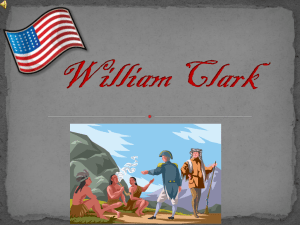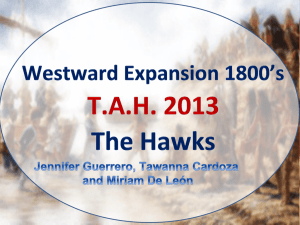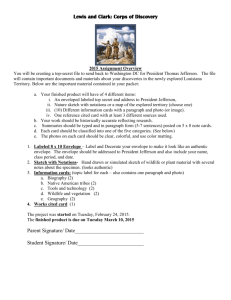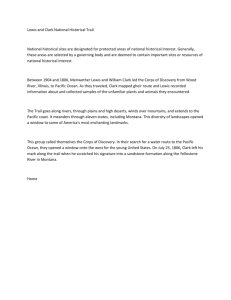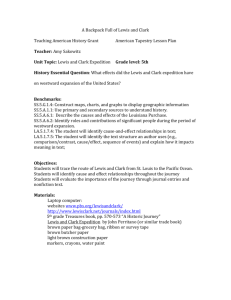Defining US: The American Experience
advertisement
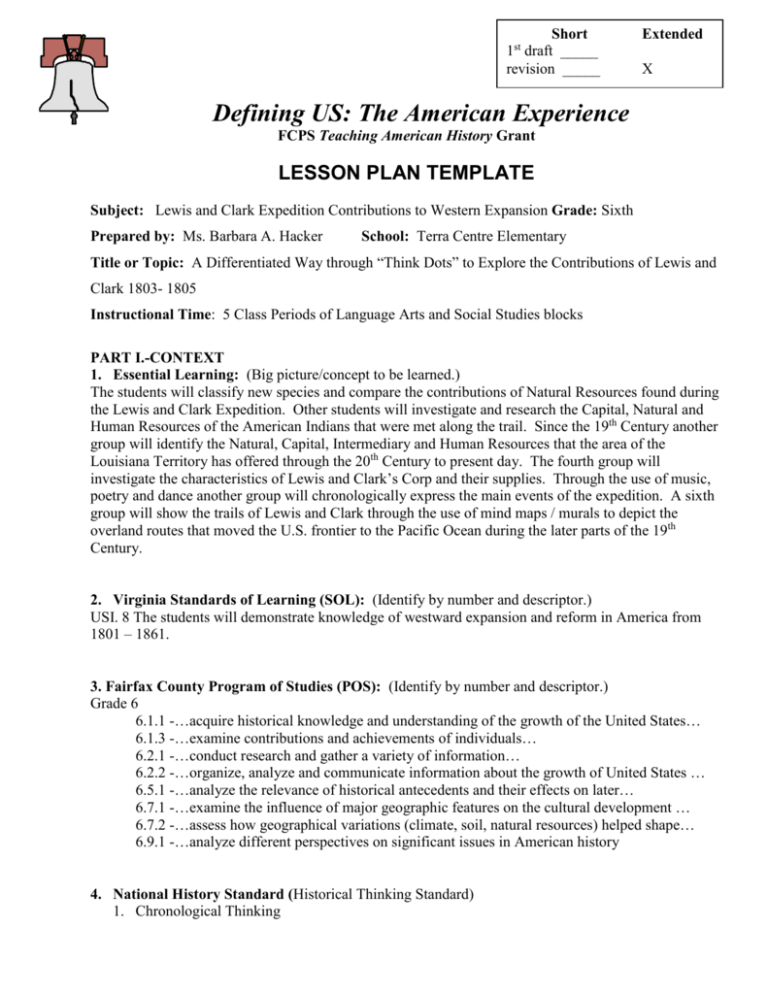
Short 1 draft _____ revision _____ Extended st X Defining US: The American Experience FCPS Teaching American History Grant LESSON PLAN TEMPLATE Subject: Lewis and Clark Expedition Contributions to Western Expansion Grade: Sixth Prepared by: Ms. Barbara A. Hacker School: Terra Centre Elementary Title or Topic: A Differentiated Way through “Think Dots” to Explore the Contributions of Lewis and Clark 1803- 1805 Instructional Time: 5 Class Periods of Language Arts and Social Studies blocks PART I.-CONTEXT 1. Essential Learning: (Big picture/concept to be learned.) The students will classify new species and compare the contributions of Natural Resources found during the Lewis and Clark Expedition. Other students will investigate and research the Capital, Natural and Human Resources of the American Indians that were met along the trail. Since the 19th Century another group will identify the Natural, Capital, Intermediary and Human Resources that the area of the Louisiana Territory has offered through the 20th Century to present day. The fourth group will investigate the characteristics of Lewis and Clark’s Corp and their supplies. Through the use of music, poetry and dance another group will chronologically express the main events of the expedition. A sixth group will show the trails of Lewis and Clark through the use of mind maps / murals to depict the overland routes that moved the U.S. frontier to the Pacific Ocean during the later parts of the 19th Century. 2. Virginia Standards of Learning (SOL): (Identify by number and descriptor.) USI. 8 The students will demonstrate knowledge of westward expansion and reform in America from 1801 – 1861. 3. Fairfax County Program of Studies (POS): (Identify by number and descriptor.) Grade 6 6.1.1 -…acquire historical knowledge and understanding of the growth of the United States… 6.1.3 -…examine contributions and achievements of individuals… 6.2.1 -…conduct research and gather a variety of information… 6.2.2 -…organize, analyze and communicate information about the growth of United States … 6.5.1 -…analyze the relevance of historical antecedents and their effects on later… 6.7.1 -…examine the influence of major geographic features on the cultural development … 6.7.2 -…assess how geographical variations (climate, soil, natural resources) helped shape… 6.9.1 -…analyze different perspectives on significant issues in American history 4. National History Standard (Historical Thinking Standard) 1. Chronological Thinking 2. Create time lines 3. Historical comprehension 4. Reconstruct literal meaning from historical passage 5. Draw upon historical maps 6. Use visual data 7. Historical Analysis and Interpretation 8. Consider multiple perspective 9. Hypothesize about influences of the past 10. Gather needed knowledge of time and place to construct a story explanation or narrative 5. Learning Strategy(s) Objectives: 1. Students will be able to: Explain incentives that led people to explore Identify the “West” as defined following the Revolutionary War Explain that, over time, the location of the West changed for Americans Explain that the East was becoming overcrowded and resources became limited – the West offered new and plentiful resources Explain the importance of the Mississippi River and the port of New Orleans Develop questions that would be prepared for to investigate a new area such as a trip to the moon Explain the “Hierarchy of Survival” Develop a time line of dates and events leading up to the Lewis and Clark Expedition Define trade and opportunity cost Give examples of opportunity cost and incentives Define economic value and price Explain that economic value of something depends on both its desirability and scarcity Develop guidelines for picking expedition crew and decide on special skills each crew member needed to have to serve as human resources Decide on capital resources and intermediary resources necessary for expedition Describe how the American Indians met by the Lewis and Clark Expedition used their environment to obtain food, clothing, and shelter. Make connections between the past and the present Connection to TAH grant: Content: Use of primary resources and lectures from The American History Grant Cohort III Method to explore different resources and internet sites Presentation of material will correspond to the students’ learning styles Notes from Dr. Herman Viola (The National Museum of the American Indian 3/16/05) o Dr. Viola is an Honorary member of the Crow Tribe o Personal account of the benefits of the Lewis and Clark Expedition Bites from Dr. Elliot West, Historian, April 6th,2005, Manifest Destiny and the “Dream” Pedagogy: Methods of grouping and presenting materials and information Jigsaw o Grouping with different secondary resources to read and compare information that will fit with their Thinking Dot project Thinking Dots o Students will look at all the Thinking Dot colored cards and make a selection of the final project they will complete during the five day period Internet o Some students will investigate multiple American History sites to copy and paste graphics for their final project o All students will complete the Summary Sheet that will account for the Historical Events and Significance this Expedition’s Discoveries and how it influenced the Westward Movement Era. PART II. 1. Assessment: Attachment #1 o EXPERT SHEET: Students will document natural resources found for Think Dot One project. Attachment #2 o SUMMARY SHEET: Historical Events and the Significance will be summarize by each student Attachment #3 o RUBRIC: During oral presentation of their Think Dot Project assessment will be taken for each area: o Product Content o Display of Chart, Journal of Graphs and Murals or Mind Map o Rhythmic and / or Dramatic Performance 2. Instructional Strategies: o Opener: What action should the United States take? A. Offer to buy the city of New Orleans from France so that American farmers can export their goods from that port. B. Threaten to go to war if France does not hand over New Orleans to the United States C. Offer to buy all of the Louisiana Territory, including New Orleans, so that the French are no longer a threat to the United States. Explain Thomas Jefferson’s choice… o Why did Americans want to explore Western Land? o Floor drawing of United States divided into sections o Students stand in section one (NE area)…More students crowd into section one o Students then move into SE section two … More students crowd into section two o As students crowd into Eastern areas all students are pushed West o Read Aloud o Seaman’s Journal On the Trail with Lewis and Clark, by Patricia Reeder Eubank o Review “Hierarchy of Survival” previously taught as a survival strategy. o Break Out Sessions into Think Dot Groups for Jigsaw o Students will revisit their choices on the Multiple Intelligence Survey o Students sort and read through different non fiction resources to discover books that they will refer back to for reference o Choose Think Dot Project Group that they wish to be a part of for the 5 day lesson o Laptops will be brought into classroom for research o Think Dot One: o Students will investigate primary sources for drawings of Natural Resources that the Corp of Discovery discovered. They will note the categories and analyze the details that the explorers wrote down as they discovered new natural resources of the Louisiana Territory. o Prior to the lesson, I will teach them how to read the Field Book of Natural History, by E. Laurence Palmer (Professor of Nature and Science Education, Cornell University, Director of Nature Education for Nature Magazine). o Students will use an EXPERT SHEET on the computer to copy and paste 20 primary source drawings from the Lewis and Clark Expedition o Student “Scientists” will draw a map of an unfamiliar park in Burke Lake Park prior to exploring it for natural resources. This will simulate the drawings of William Clark prior to his investigation of the Louisiana Territory. o Student “Scientists” will meet me at Burke Lake Park to hike through the park and collect various natural resources. o An EXPERT SHEET will be filled in to keep a record of findings. Investigation and observation of the objectives will help them to identify their characteristics and significance. o Students will report and show a display to the class and summarize the historical events of Lewis and Clark’s treasure of discoveries and their significance to inspire others to move Westward. o Think Dot Two: o Students will research and investigate through the use of the internet and secondary books and periodicals the Natural, Capital, Intermediary and Human Resources that Lewis and Clark discovered on their Expedition of 1803 – 1805. o Students will identify that the Lewis and Clark Expedition traveled through the current day states of Missouri, Kansas, Iowa, Nebraska, South Dakota, Wyoming, Montana, Idaho, Washington and Oregon. o Students will compare the resources found by the Lewis and Clark Expedition and found today in those areas. o Students will make resource maps that are hand generated or generated through Publisher or Power Point. Use of graphics will enhance their maps. o Each student will discriminate between the natural, capitol, intermediary and human resources found in both eras of study. o Students will report and show maps to the class. Afterwards they will summarize the historical events of Lewis and Clark’s findings of resources and their significance to inspire others to move Westward. o Think Dot Three: o Each will make connections between the past and the present o Through research of the Natural Resources found during the expedition the students will conclude that rich resources drew in commerce for the fur trade and many other merchants. o After studying the early resources of the area students will research the current day resources and production of the area today. o They will compare the production sales of the 20th Century to the production sales of the present. o Students will graph using Excel or hand drawn graphs to represent the growth or decline from 1900 to the present o They will add a cover to their final product and download graphics about the land and location of the Natural Resources / Capital Resources and Intermediary Resources. o Students will report and show maps to the class. Afterwards they will summarize the historical events of Lewis and Clark’s findings of resources and their significance to inspire others to move Westward. o Think Dot Four: o Students will investigate the biographies of the Lewis and Clark Corp of Discovery crew members and the First Americans who they met. o The students will report on the supplies they took with them for the two year expedition and the goods bartered or traded by the Explorers and the First Americans. o Students will show the Incentives brought on the Expedition to use in bartering or trading. Students will also explain that Opportunity Costs were a constant for both the Corp of Discovery and the American Indians. o Students will differentiate between the terms Barter and Trade o Each of the students will role play by pretending to be a character of the Corp of Discovery or Lewis and Clark and a present day News Reporter who will interview the explorer. o Students will explore the “Point of View” (which was observed through the reading of Seaman’s Journal On the Trail with Lewis and Clark, as our read aloud at the beginning of this lesson). o Students will present their performance to the class. Afterwards they will summarize the historical events of Lewis and Clark’s findings of resources and their significance to inspire others to move Westward. o Think Dot Five: o Students will chronologically in a Time Line display the events, people, land, location and many contributions to America from the Lewis and Clark Expedition. o They will search the internet for graphics of maps, resources, people and other contributions that document the two year tour of The Corps of Discovery under the guidance of Lewis and Clark, 1803 -1805. o Students will display the time line and write lyrics to a song, rap or a poem or a dance that will chronically show the events and contributions of this historical expedition. o Students will present their performance to the class. Afterwards they will summarize the historical events of Lewis and Clark’s findings of resources and their significance to inspire others to move Westward. o Think Dot Six o Students will research through primary resources on the internet and in books the trails of the Lewis and Clark Expedition o Some students will research through other secondary resources the maps of the old trails. o Through Power Point Presentations, cut paper murals or Mind Maps they will display the old trails. o A comparison will be researched to show the later 19th Century Overland Trials and finally the students will show Interstate Road Maps of today to see how the change to safe routes. o Students will also research and show the Natural Resources and Capital Resources that moved Americans across the frontier to the Pacific Ocean. o Students will present their performance to the class. Afterwards they will summarize the historical events of Lewis and Clark’s findings of resources and their significance to inspire others to move Westward. 3. Materials/Resources to be used: o Glossary of Terms – The Louisiana Expansion o American Library of Congress Site American Memories o Internet sites from GT Site on 24 / 7 of the FCPS site o Secondary Reference Books and Magazines 4. Differentiation: o Free Choice to pick Think Dot Project o Opportunity to work in their own Multi-Intelligence Group with a project that fits their style o Research with a partner o “Lunch Bunch” and after school help for those students who need help 5. Annotated Bibliography: o Seaman’s Journal On the Trail with Lewis and Clark, Patricia Reeder Eubank, Ideas Children’s Books, Nashville, TN, 2002, ISBN 0-8249-5442-4 o Seaman’s Journal is an account of that expedition as seen from the viewpoint of the dog, Seaman. His preparations for the trip as he helps pack food and supplies, including trinkets they took to give away. Meet the Native American guides and friends they encountered along the way. Read Seaman’s account of grizzly bears, buffalos, and even kidnappers - of Seaman! o Lewis and Clark, Voices from the Trail, Michael Kerrigan, Barnes and Noble Books, New York, 2004, ISBN 0-7607-5314-8 o A stunningly illustrated book tells the story of the remarkable Lewis and Clark Expedition in the words of the explorers themselves. It mixes the old with the new by using reproductions of etchings and paintings with photographs of the area today. It explains that even thought Lewis and Clark didn’t find the Northwest Passage they did find valuable information that would help the next generation to ship freight upriver and over the Western mountains to the coast beyond. This was a viable way through to the Pacific that would open up America to Asian trade. o How We Crossed the West The Adventures of Lewis and Clark, Rosalyn Schanzer, National Geographical Society, Washington, D.C., 2002, ISBN 0-7922-6776-5 o The story of the Lewis and Clark Expedition written in journal writing as if spoken from the explorers themselves. Colorful, action-filled pictures and a text drawn from the actual journals and letters written by Lewis and Clark and members of the expedition. Easy reading for young readers. o LEWIS and CLARK on the Trail of Discovery – The Journey that Shaped America, A Museum in a Book, Rod Gragg, Rutledge Hill Press, 2003, ISBN 1-4016-0076-0075-1 o Through the use of reproductions of the original letters written between Thomas Jefferson, Meriwether Lewis, William Clark, and their Corps of Discovery Explorers the author of this book gives a vivid and inspiring account of this two year expedition. The letter Meriwether Lewis wrote to his mother reassuring her of the importance and safety of his mission is moving. The code Thomas Jefferson provided to Lewis for sending a secret message. It says…The Lewis and Clark expedition’s greatest achievement was its impact on the American people. o For Beyond Lewis & Clark – The Army Explores the West, Washington State Historical Society in association with the Virginia Historical Society, Kansas Historical Society, Frontier Army Musuem, a pamphlet, 2004 o Easy to read and vivid with articles that give time lines, vocabulary definitions, specialists definitions, and descriptive articles about Jefferson decision to select Meriwether Lewis and William Clark and the Corps of Discovery to explore and discover a wealth of information leading to a route to the Pacific. It gives articles that explain the incentives sent with the Expedition. Various points of view of the American Indians that were closed out of the West because of the future pioneers who would settle this area. o Everything You Need to Know About American History Homework, A Desk Reference for Students and Parents, Anne Zeman and Kate Kelly, Scholastic, 1997, ISBN 0-59049393-9 Internet Sites: http://memory.loc.gov/ammen/gmdhome.html http://www.besthistorysites.net/ http://odur.let.rug.nl/~usa/ http://www.eduplace.com/ss/maps/usa.html http://home.comcast.net/~dboals1/boals.html
